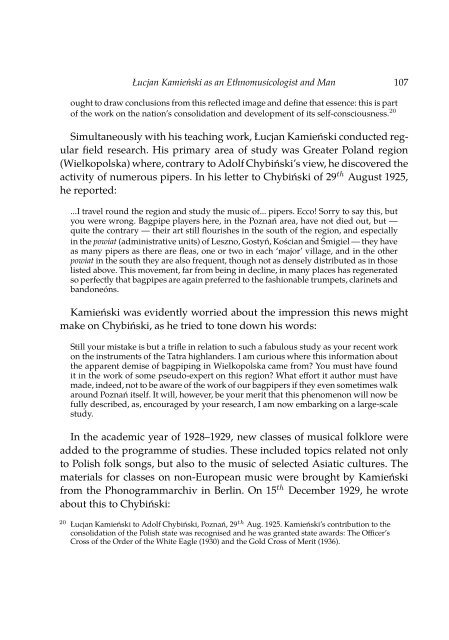Musicology Today 2012 100 Years of Polish Musicology
Musicology Today 2012 100 Years of Polish Musicology
Musicology Today 2012 100 Years of Polish Musicology
You also want an ePaper? Increase the reach of your titles
YUMPU automatically turns print PDFs into web optimized ePapers that Google loves.
Łucjan Kamieński as an Ethnomusicologist and Man 107<br />
ought to draw conclusions from this reflected image and define that essence: this is part<br />
<strong>of</strong> the work on the nation’s consolidation and development <strong>of</strong> its self-consciousness. 20<br />
Simultaneously with his teaching work, Łucjan Kamieński conducted regular<br />
field research. His primary area <strong>of</strong> study was Greater Poland region<br />
(Wielkopolska) where, contrary to Adolf Chybiński’s view, he discovered the<br />
activity <strong>of</strong> numerous pipers. In his letter to Chybiński <strong>of</strong> 29 th August 1925,<br />
he reported:<br />
...I travel round the region and study the music <strong>of</strong>... pipers. Ecco! Sorry to say this, but<br />
you were wrong. Bagpipe players here, in the Poznań area, have not died out, but —<br />
quite the contrary — their art still flourishes in the south <strong>of</strong> the region, and especially<br />
in the powiat (administrative units) <strong>of</strong> Leszno, Gostyń, Kościan and Śmigiel — they have<br />
as many pipers as there are fleas, one or two in each ‘major’ village, and in the other<br />
powiat in the south they are also frequent, though not as densely distributed as in those<br />
listed above. This movement, far from being in decline, in many places has regenerated<br />
so perfectly that bagpipes are again preferred to the fashionable trumpets, clarinets and<br />
bandoneóns.<br />
Kamieński was evidently worried about the impression this news might<br />
make on Chybiński, as he tried to tone down his words:<br />
Still your mistake is but a trifle in relation to such a fabulous study as your recent work<br />
on the instruments <strong>of</strong> the Tatra highlanders. I am curious where this information about<br />
the apparent demise <strong>of</strong> bagpiping in Wielkopolska came from You must have found<br />
it in the work <strong>of</strong> some pseudo-expert on this region What effort it author must have<br />
made, indeed, not to be aware <strong>of</strong> the work <strong>of</strong> our bagpipers if they even sometimes walk<br />
around Poznań itself. It will, however, be your merit that this phenomenon will now be<br />
fully described, as, encouraged by your research, I am now embarking on a large-scale<br />
study.<br />
In the academic year <strong>of</strong> 1928–1929, new classes <strong>of</strong> musical folklore were<br />
added to the programme <strong>of</strong> studies. These included topics related not only<br />
to <strong>Polish</strong> folk songs, but also to the music <strong>of</strong> selected Asiatic cultures. The<br />
materials for classes on non-European music were brought by Kamieński<br />
from the Phonogrammarchiv in Berlin. On 15 th December 1929, he wrote<br />
aboutthistoChybiński:<br />
20 Łucjan Kamieński to Adolf Chybiński, Poznań, 29 th Aug. 1925. Kamieński’s contribution to the<br />
consolidation <strong>of</strong> the <strong>Polish</strong> state was recognised and he was granted state awards: The Officer’s<br />
Cross <strong>of</strong> the Order <strong>of</strong> the White Eagle (1930) and the Gold Cross <strong>of</strong> Merit (1936).
















